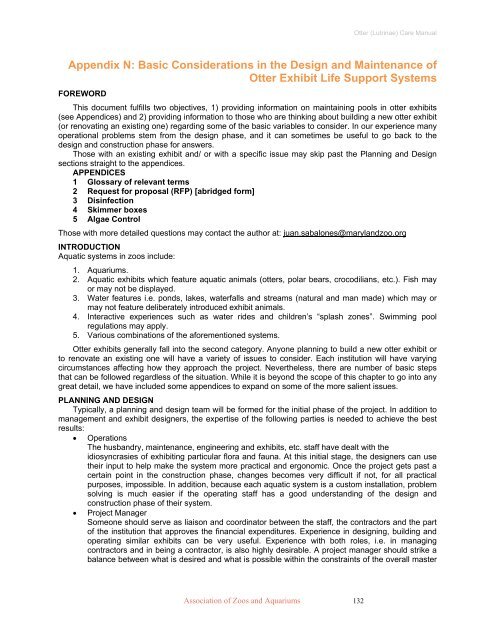Otter (Lutrinae) Care Manual - Association of Zoos and Aquariums
Otter (Lutrinae) Care Manual - Association of Zoos and Aquariums
Otter (Lutrinae) Care Manual - Association of Zoos and Aquariums
You also want an ePaper? Increase the reach of your titles
YUMPU automatically turns print PDFs into web optimized ePapers that Google loves.
<strong>Association</strong> <strong>of</strong> <strong>Zoos</strong> <strong>and</strong> <strong>Aquariums</strong> 132<br />
<strong>Otter</strong> (<strong>Lutrinae</strong>) <strong>Care</strong> <strong>Manual</strong><br />
Appendix N: Basic Considerations in the Design <strong>and</strong> Maintenance <strong>of</strong><br />
<strong>Otter</strong> Exhibit Life Support Systems<br />
FOREWORD<br />
This document fulfills two objectives, 1) providing information on maintaining pools in otter exhibits<br />
(see Appendices) <strong>and</strong> 2) providing information to those who are thinking about building a new otter exhibit<br />
(or renovating an existing one) regarding some <strong>of</strong> the basic variables to consider. In our experience many<br />
operational problems stem from the design phase, <strong>and</strong> it can sometimes be useful to go back to the<br />
design <strong>and</strong> construction phase for answers.<br />
Those with an existing exhibit <strong>and</strong>/ or with a specific issue may skip past the Planning <strong>and</strong> Design<br />
sections straight to the appendices.<br />
APPENDICES<br />
1 Glossary <strong>of</strong> relevant terms<br />
2 Request for proposal (RFP) [abridged form]<br />
3 Disinfection<br />
4 Skimmer boxes<br />
5 Algae Control<br />
Those with more detailed questions may contact the author at: juan.sabalones@maryl<strong>and</strong>zoo.org<br />
INTRODUCTION<br />
Aquatic systems in zoos include:<br />
1. <strong>Aquariums</strong>.<br />
2. Aquatic exhibits which feature aquatic animals (otters, polar bears, crocodilians, etc.). Fish may<br />
or may not be displayed.<br />
3. Water features i.e. ponds, lakes, waterfalls <strong>and</strong> streams (natural <strong>and</strong> man made) which may or<br />
may not feature deliberately introduced exhibit animals.<br />
4. Interactive experiences such as water rides <strong>and</strong> children’s “splash zones”. Swimming pool<br />
regulations may apply.<br />
5. Various combinations <strong>of</strong> the aforementioned systems.<br />
<strong>Otter</strong> exhibits generally fall into the second category. Anyone planning to build a new otter exhibit or<br />
to renovate an existing one will have a variety <strong>of</strong> issues to consider. Each institution will have varying<br />
circumstances affecting how they approach the project. Nevertheless, there are number <strong>of</strong> basic steps<br />
that can be followed regardless <strong>of</strong> the situation. While it is beyond the scope <strong>of</strong> this chapter to go into any<br />
great detail, we have included some appendices to exp<strong>and</strong> on some <strong>of</strong> the more salient issues.<br />
PLANNING AND DESIGN<br />
Typically, a planning <strong>and</strong> design team will be formed for the initial phase <strong>of</strong> the project. In addition to<br />
management <strong>and</strong> exhibit designers, the expertise <strong>of</strong> the following parties is needed to achieve the best<br />
results:<br />
• Operations<br />
The husb<strong>and</strong>ry, maintenance, engineering <strong>and</strong> exhibits, etc. staff have dealt with the<br />
idiosyncrasies <strong>of</strong> exhibiting particular flora <strong>and</strong> fauna. At this initial stage, the designers can use<br />
their input to help make the system more practical <strong>and</strong> ergonomic. Once the project gets past a<br />
certain point in the construction phase, changes becomes very difficult if not, for all practical<br />
purposes, impossible. In addition, because each aquatic system is a custom installation, problem<br />
solving is much easier if the operating staff has a good underst<strong>and</strong>ing <strong>of</strong> the design <strong>and</strong><br />
construction phase <strong>of</strong> their system.<br />
• Project Manager<br />
Someone should serve as liaison <strong>and</strong> coordinator between the staff, the contractors <strong>and</strong> the part<br />
<strong>of</strong> the institution that approves the financial expenditures. Experience in designing, building <strong>and</strong><br />
operating similar exhibits can be very useful. Experience with both roles, i.e. in managing<br />
contractors <strong>and</strong> in being a contractor, is also highly desirable. A project manager should strike a<br />
balance between what is desired <strong>and</strong> what is possible within the constraints <strong>of</strong> the overall master









